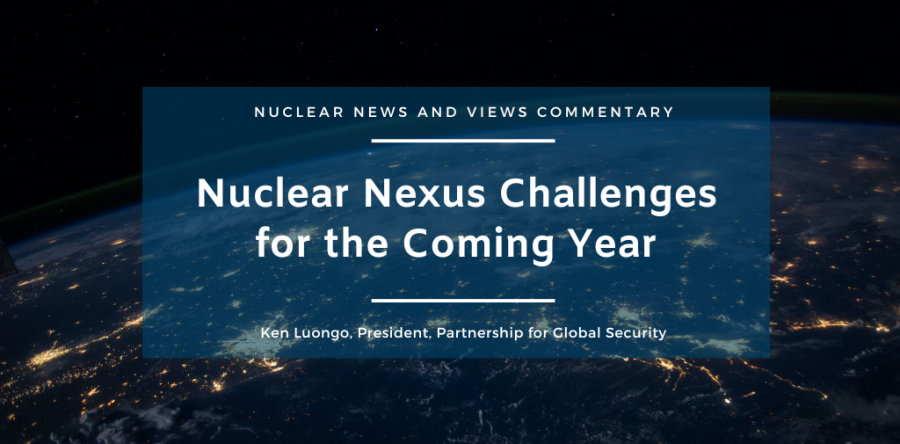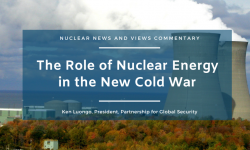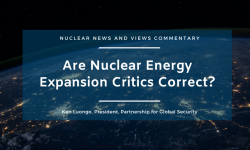| The decision by 25 nations at the COP28 international climate conference to support the tripling of nuclear energy by 2050 was a major milestone in the recognition of reality about how global zero-carbon energy will be achieved. This is a big aspiration and probably an unattainable objective. One analysis notes that this goal will require building “the equivalent of about 50 large nuclear power reactors per year until 2050.” But its ambitious scale should drive an evolution in how nuclear power is effectively commercially deployed. Among the numerous issues that need attention, there are three critical areas that will require an evolution of thinking and policy in the coming year: 1. Winning the geopolitical competition for reactor exports. 2. Preparing the international market for smaller reactors. 3. Constructing an effective policy framework for nuclear energy’s expansion. Geopolitics The U.S. faces a dual competition in the large and small nuclear reactor export arena. One battle is with its adversaries in Russia and China. The other is with its allies in South Korea and Europe. The challenges from Russia and China are well characterized. Current nuclear reactor exports are dominated by Russia. Its large-scale reactors are under construction in Egypt, Turkey, China, India, Bangladesh, Belarus, and Hungary. Russia’s major state-owned nuclear company, Rosatom, had over $10 billion in sales overseas in 2022. Current reactor building is dominated by China, which has over 20 plants under construction and is planning to build 150 more by mid-century. Both countries financially underwrite their nuclear industries, have hot production lines, and support sophisticated workforce education and development systems. They also identify nuclear power as a geopolitical and energy asset and are actively cultivating energy export markets in the developing economy world. The challenge from America’s allies is different. It revolves around intense commercial competition for new nuclear business without the same, deep level of governmental support. There has been a glaring inability of the governments and major companies to understand how they can and need to work together to overcome the structural advantages enjoyed by Russia and China. The failure to outmaneuver Russia and China in this competition will have significant international and energy security implications for the remainder of this century. The U.S., over the past seven years, has done a good job of hip checking Russia and China out of key European markets, most prominently the Czech Republic and Romania. The U.K. and Finland also have terminated reactors deals with China and Russia respectively because of concerns about energy security and interference. The American Bipartisan Infrastructure Deal and the Inflation Reduction Act have provided a significant funding boost for existing and new-design nuclear plants. Further, the U.S. is actively working to eliminate its dependence on Russian nuclear fuel, which has been described by the Biden administration as “gravely concerning”. While there is no active remedy for Russian fuel imports for existing reactors, the U.S. has put resources into restarting its uranium enrichment capability for next-gen reactors. This has produced the first kilograms of HALEU fuel outside of Russia and has the U.K. following the American lead in this area. But the question is whether these individual actions add up to the cohesive strategy that is needed to win a global nuclear market that may not triple in size over the next 25 years, but certainly will expand. Market Development The necessity of a cohesive strategy is illustrated by the increasingly complicated competition for international nuclear export share. The large reactor competition is centered on Eastern Europe and The Middle East. These markets are well characterized and present a specific set of opportunities and challenges that established reactor vendors and governments understand. What is not well understood is the emerging economy nation market for scaled down reactors like SMRs and advanced technologies. These next-gen technologies are under development in western countries, but some already have been deployed in Russia and China. A new Nuclear Business Platform report illustrates some of the new challenges for western nuclear export to new nuclear nations. This analysis identifies Ghana, Uganda, Nigeria, and Zambia as four African nations in the “Tier 1” category of nations “firmly committed” to starting nuclear power programs. Egypt and South Africa also were on that list, but South Africa already operates a nuclear power facility and Egypt is currently building one. Ghana is of particular interest to western reactor exporters. The U.S. has signed a memorandum of understanding on civil nuclear cooperation with the government. The country also is a partner in the State Department’s FIRST program and the U.S. has committed $1.75 million to create a Ghana-based SMR regional training hub for sub-Saharan Africa. Japan has joined in to support technical and regulatory assessments in the country under the WECAN initiative. And the first-ever pan-African U.S.-Africa Nuclear Energy Summit was held in Accra in November. But despite all that useful activity, as of November, Ghana along with Zambia, are countries to which the U.S. EXIM bank will not provide any support. It is unlikely that any U.S. nuclear supplier will be able to export a reactor to either country without EXIM support. So, there seems to be a disconnect in the nuclear export ecosystem. In general, the financing, strategy, and tempo of U.S. and allied nation cultivation and preparation of new nations actively seeking nuclear power is insufficient for the opportunity. There are numerous structural and financial reasons for this. But in the meantime, China has a clear advantage under the Belt and Road initiative in the development of energy and infrastructure relationships with many of these markets. And Russia has set its sights on Africa as a prime nuclear export target. Policy Framework The notional timeframe for the deployment of next-generation nuclear energy is roughly 10-15 years. Because of the novel aspects of many of these reactor designs and fuel cycles a new framework for the management of these technologies is going to be required. Chief among these is the need to evolve the regulatory regime to reflect the differences between advanced and conventional reactors. Regulatory evolution is occurring as is cooperation on standards across borders. So, while critics have pounced on the slowness of this transition, the hope is that an effective new system can be developed and internationally propagated. The Achilles Heel of all nuclear projects traditionally has been cost and schedule. These double dangers are clearly evidenced in the problems encountered by the SMR company, NuScale. Some of its competitors have also faced similar problems in recent months. If this situation persists it likely will present a major competitiveness headwind to next-gen reactor deployment. The question is whether governments and industry can find more effective ways than pure market approaches to minimize or limit these challenges to facilitate deployment. The competitiveness challenges also are exacerbated by the fact that OECD nuclear exporting nations are subject to requirements that are more stringent than those followed by Russia and China. In the current environment, these limits are probably outdated. The restrictions on producing a “package deal” with government guarantees that are more attractive than Russian or Chinese offerings to new nations considering nuclear units is a millstone. The other prominent policy issues that need attention are nuclear non-proliferation, nuclear security, and spent fuel management. The objective here is to adapt international guidelines to the new technologies so that nuclear weapons cannot be developed, and the reactors are protected from nuclear terrorism. This process is underway, but it lacks prioritization. The role of nuclear energy was a major theme at the Dubai climate confab. The central commitment to triple nuclear power in 25 years was a milestone. But its roster of supporters did not include Russia or China. Maybe those nations believe they already have an effective plan for how to control the future international nuclear market. If so, a better strategy needs to be created by western nations and they will need to evolve their thinking and policies to get there. |
Ken Luongo, President, Partnership for Global Security





